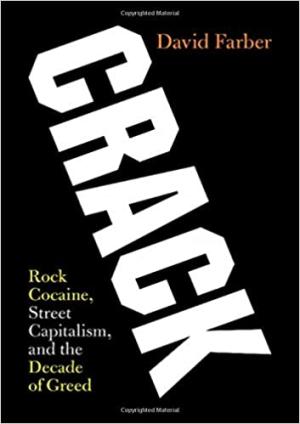Crack: Rock Cocaine, Street Capitalism, and the Decade of Greed by David Farber (2019, Cambridge University Press, 214 pp., $24.95 HB)

University of Kansas historian David Farber takes the reader back to the days of vial-filled streets, especially the mid-1980s, when the emergence of this smokable form of cocaine, available in cheap, single dose units (rocks) made a drug that was formerly the province of the wealthy and well-connected a mass market commodity. A gram of powder cocaine, after all, was going for $100, but you could pick up a rock of crack and get an instant high for $5.
The problem was that the $5 high was gone in a few minutes. A lot of people, Farber notes, used crack recreationally. They'd buy a pocketful of rocks, smoke 'em up, and call it a night. But for some people, the crack high proved so alluring, the urge to hit the pipe so irresistible, that they lost everything to the drug. Their possessions -- pawned for pennies on the dollar to get another rock -- and then their friends' and families' possessions, thieved for more rocks, their cars, their homes -- all gone to feed a habit so compulsive women would give blow jobs in alleys for enough money for another rock and men would steal old ladies' purses in the street.
But who would find something like that alluring? Farber points to ethnologist Philippe Bourgeois, who lived among and wrote about a group of Queens crack dealers and their clientele, for an explanation: "Crack as a preferred drug of abuse only appeals to desperate population subgroups who are victims of extreme forms of structural violence," Bourgeois wrote.
Farber himself elaborates on that theme: "Crack become so popular and then so problematic in poor communities... because most of the people drawn to chronic crack use were already in deep trouble of all kinds before they took their first hit," he writes. "The trouble -- economic, educational, psychological, cultural… the list goes on -- was shaped by the callous and racist society in which they lived. And then once these troubled people started using crack, most every kind of authority, from the police to social workers to local prosecutors, mostly made their lives worse rather than trying to help them."
It didn't help, Farber explains, that the crews getting rich off selling crack were almost entirely Black, whether Dominicans, Jamaicans, or African-Americans. That made it all the easier for mass media and politicians to demonize them, and indeed, fed by a feast of sensational crack stories, by 1988, nearly two-thirds of American cited drugs as the worst problem facing the country. And by drugs, they largely meant crack.
The political response to the ravages of crack -- not just the decimation of its users but also the violence and disorder of the black-market crack trade -- was savage. At the federal level, Farber traces the three separate crime bills in the 1980s and 1990s (including one in which Joe Biden played a significant role) that paved the way for mass incarceration), including the creation of the infamous 100:1 crack vs. powder cocaine sentencing disparity.
But going after Michelle Alexander's thesis in The New Jim Crow that the crackdown on crack was driven almost entirely by racism, Farber draws out the leading role played by Black politicians, particularly Rep. Charles Rangel of New York, who hounded the Republicans in power in the 1980s to lower the hammer. In so doing, Rangel was responding to increasingly loud complaints from his Black constituents, who for obvious reasons didn't want gun battles, thefts, and dissolute behavior on their doorsteps.
But while federal crack prosecutions helped stuff the federal prison system to the rafters, states and localities certainly added to the repression. Farber points to Chicago, where by 1987 the number of drug cases alone more than doubled the total number of felony cases in the county just a dozen years earlier. The creation in 1989 of a special drug court to handle crack cases dramatically accelerated a streets-to-prison pipeline. The special crack court simply rationalized and made more efficient the effort that sent thousands of mainly Black Chicagoans into the state prison system.
Farber also takes a fascinating look at the links between crack, crack culture, and hip-hop, which all emerged at roughly the same time in the same places, and some of whose stars (Snoop Dogg, 50 Cent, Biggie Smalls) grew up in the trade. The garish displays of wealth endemic to both the trade and hip-hop culture, were symbols of status in impoverished communities.
And wasn't that what America was all about? The 1980s, after all, was the era of "greed is good," and if that attitude held on Wall Street, it also held on the streets. Farber doesn't excuse the violence of the trade -- it precipitated a large increase in murders nearly everywhere it emerged -- or the callousness of knowingly selling an addictive, life-wrecking drug to one's neighbors -- nor does he minimize the damage done to the users most in its grip (and their families and their communities), but he expresses some sympathy for the people whose only real access to the American dream was through slingin' rocks.
"For a short while in the 1980s and 1990s" he writes, "crack was the main chance for tens of thousands of unemployed, undercapitalized young men who dreamed of a world where they were rich and respected and admired. The crack sellers and the crack bingers invented a consumer marketplace with the tools they had on hand and within the possibilities they could imagine. Within their economic and cultural realm, in a broader culture of entrepreneurial greed, what they did made sense."
Crack is a fine work of social and cultural history. If you thought you already knew all about crack, think again, then go out and add this to your library.
This work by StoptheDrugWar.org is licensed under Creative Commons Attribution-ShareAlike 4.0 International
Add new comment